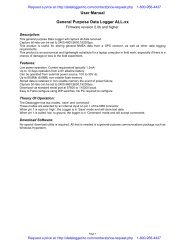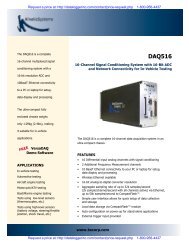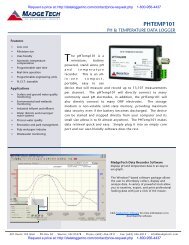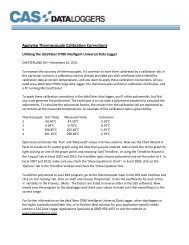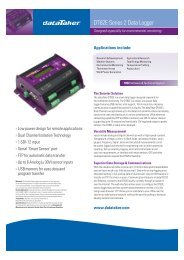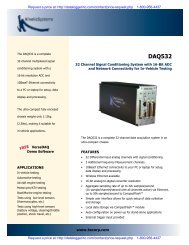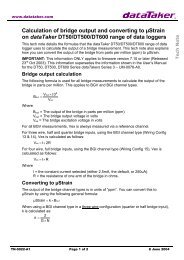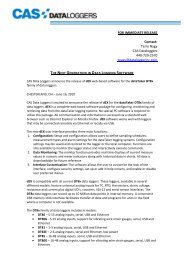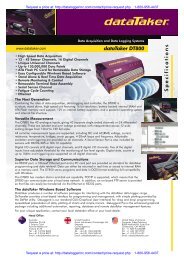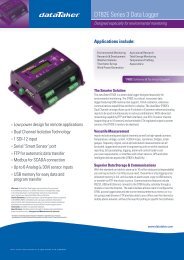Data acquisition over mobile networks made easy
Data acquisition over mobile networks made easy
Data acquisition over mobile networks made easy
Create successful ePaper yourself
Turn your PDF publications into a flip-book with our unique Google optimized e-Paper software.
<strong>Data</strong> <strong>acquisition</strong> <strong>over</strong> <strong>mobile</strong> <strong>networks</strong><strong>made</strong> <strong>easy</strong>1 OverviewThe new dataTaker DT80M, DT85M, DT82EM, DT85GM models have all the samefeatures you expect from the DT80 range, with the addition of Mobile network connectivitybuilt in. Previously, connecting an external modem and developing an application tocontrol the modem and deliver the data and alarm information to your computer has been<strong>over</strong>ly complicated and at times less than reliable. The new "M" models have solved theseissues by integrating a GSM/EDGE/UMTS/HSPA modem internally. But this is no ordinaryintegration; we have gone to great lengths to ensure that the modem and logger workseamlessly together.The configuration of the logger for use <strong>over</strong> <strong>mobile</strong> <strong>networks</strong> has been <strong>made</strong> really <strong>easy</strong> inour dEX configuration tool. In fact, the logger will automatically detect when arecommended SIM card is inserted and will automatically configure itself for use with theassociated <strong>mobile</strong> network.The logger now directly supports sending alarm information as either an SMS or Emailmessage. <strong>Data</strong> can be sent regularly or can be triggered by an event or request. This datacan be delivered to you as either an Email message with data attached, or pushed to anFTP server.2 SIM supply, provisioning and configurationTraditionally, acquiring and provisioning a SIM card for use in data <strong>acquisition</strong> tasks hasbeen difficult to do. Often, the person representing the <strong>mobile</strong> phone network does notreally have the knowledge to correctly supply and provision a SIM card for use in theseapplications.For some markets, e.g. Australia, we have worked with our preferred <strong>mobile</strong> phonenetwork operator so that we can supply a SIM card with each "M" model logger. Includedwith the SIM card is an application form so you can quickly establish an account, activatethe SIM, and get up and running within a couple of hours.The logger will automatically recognize a SIM card from one of our preferred <strong>mobile</strong> phonenetwork operators, and configure the required network settings (APN, SMTP server etc.)automatically. If the SIM card is not one that the logger recognizes it can still be used bymanually setting these parameters using the dEX graphical user interface.For most functions, the logger can use almost any SIM that has data enabled. If yourequire remote access to dEX <strong>over</strong> the <strong>mobile</strong> network then you will need to get a SIM thatsupports a public IP address. A static, public IP address allows the logger to be addressed
on the internet from any computer using the IP address of the logger. The logger alsosupports DDNS so a dynamic, public address can also be used to access dEX remotely.If you only need SMS then a SIM that supports only SMS will usually be cheaper. Thelogger can be configured for SMS only operation, so that it will not attempt to connect tothe <strong>mobile</strong> network data services. SMS has the advantage that it can still work with arelatively poor signal. SMS is however restricted to only sending alarm information.3 Installation and configuration testingThe logger has several diagnostic features to aid in setting up a wireless system.The signal check feature, which can be activated on either the LCD or via the commandinterface checks the signal strength and bit error rate every few seconds and displays theresults. This allows the installer to check that the antenna is set up in the best position andthat there is adequate signal to allow communications to occur. (Note that the antennamust be located at least 500mm away from the logger to ensure that the radio signals donot interfere with analog measurements on the logger.)The 3G versions of the M models provide an antenna diversity connection for a secondantenna. This can be useful in situations where the signal is poor due to many reflections.In the dEX configuration tool there is a modem test feature which can be used to checkthat the logger is correctly configured for successful communications via SMS, Email andFTP.4 Using the <strong>mobile</strong> connectionThe logger's <strong>mobile</strong> communications capability has three main functions:• Sending alarm messages via SMS or email when user defined conditions are met.• Sending data files via FTP or email: periodically, on event, or on request.• Allowing remote access via dEX for configuration and monitoring.To allow these functions to be performed in an efficient and reliable manner, the conceptof a "communication session" has been introduced. A communications session may bestarted automatically on demand (e.g. when an alarm or data unload occurs), or atparticular times of day, or a session may be configured to be active continuously. It's atrade-off between power usage and availability.Alarm and data messages are automatically queued in the logger's internal memory untilthey have been successfully transmitted as part of a communications session. Thesequeues are preserved even if the logger is reset or suffers a power failure.If a number of alarms or data unloads occur in quick succession then the queue may fillup. In the case of alarms, a warning SMS or email will automatically be generated, alertingthe user to the possibility of missing messages. For data unloads, a full queue simplymeans that there will be more data included in the next scheduled unload. No data is lost.
which may have a better signal. If the SIM card has network "roaming" enabled thenother operators' <strong>networks</strong> will also be checked.6 PowerThe logger has been designed for push rather than pull operation. That means thelogger will initiate all communications when required. This allows the logger to havethe modem powered off when not in use, which typically saves a large amount ofpower. The downside is that while the modem is off you will not be able to connect toit remotely, for example to check current values or the status. However, the loggerprovides a simple facility (configurable in dEX or command language) to define a"time window", during which the modem will be remain powered up. This means thateach day, during the configured time period(s), you will be able to connect to thelogger remotely.There is no internal battery or 6V charger on the "M" models so for remoteapplications we recommend the use of an external 12V battery system. If using asolar panel then we recommend the use of a solar conditioner to manage the power.7 Models AvailableDT80MDT82EMDT85MDT85GM8 TechnologyGSM / GPRS / EDGE (US only)GSM / GPRS / EDGE / UMTS / HSPA (Rest of World)For customer service, call 1300-735-292To fax an order, use 1800-067-639Visit us online: www.thermofisher.com.au©2010 Thermo Fisher Scientific Australia Pty Ltd. All rights reserved. A.B.N. 52 058 390 917TR-02RD-A1



